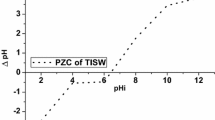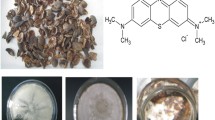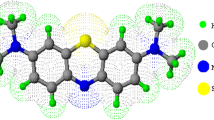Abstract
In the present investigation, the adsorption performance of sesame (Sesamum indicum) oil cake, a waste biomass from the oil extraction industry for remediation of Basic Blue 26 (BB 26) from aqueous media was examined. Effects of pH, adsorbent dosage, BB 26 concentration, shaking time temperature, and ionic strength on BB 26 adsorption have been studied in detail. The residual cake was characterized based on FTIR, zeta potential, SEM-EDAX, and BET techniques. Isotherm and kinetic data have been well-exemplified by Freundlich and pseudo second-order equations, respectively. Maximum uptake capacity was reported to increase significantly from 54.52 mg/g for unmodified cake powder to 91.24 mg/g for ZnCl2-modified cake powder, establishing the importance of ZnCl2 activation. The mechanism of BB 26 adsorption on cake powder was reported to involve different steps as predicted from the fitting of kinetic data to Weber-Morris equation. Thermodynamic studies showed that the process of BB 26 adsorption onto cake powder was accompanied by an increase in entropy and reported to be endothermic and spontaneous. Significant recovery and uptake capacity values were reported from the first to the last cycle of reusability. Due to ease of recovery and regenerability, ZnCl2-modified cake powder has been established as a promising remedy for the successful elimination of BB 26 from aqueous media.









Similar content being viewed by others
References
Ahmed M, Mashkoor F, Nasar A (2020) Development, characterization, and utilization of magnetized orange peel waste as a novel adsorbent for the confiscation of crystal violet dye from aqueous solution. Groundw Sustain Dev 10:100322
Mashkoor F, Nasar A (2020) Magsorbents: potential candidates in wastewater treatment technology – a review on the removal of methylene blue dye. J Magn Magn Mater 500:166408
Peláez-cid AA, Romero-hernández V, Herrera-gonzález AM et al (2020) Synthesis of activated carbons from black sapote seeds, characterization and application in the elimination of heavy metals and textile dyes. Chinese J Chem Eng 28:613–623
Islam MA, Ali I, Karim SMA, Hossain Firoz MS, Chowdhury AN, Morton DW, Angove MJ (2019) Removal of dye from polluted water using novel nano manganese oxide- based materials. J Water Process Eng 32:100911
Santoso E, Ediati R, Kusumawati Y, Bahruji H, Sulistiono DO, Prasetyoko D (2020) Review on recent advances of carbon based adsorbent for methylene blue removal from waste water. Mater Today Chem 16:100233
Bulgariu L, Escudero LB, Bello OS, Iqbal M, Nisar J, Adegoke KA, Alakhras F, Kornaros M, Anastopoulos I (2019) The utilization of leaf-based adsorbents for dyes removal: a review. J Mol Liq 276:728–747
Toumi K, Benguerba Y, Erto A et al (2018) Molecular modeling of cationic dyes adsorption on agricultural Algerian olive cake waste. J Mol Liq 264:127–133
Jain SN, Gogate PR (2017) Acid Blue 113 removal from aqueous solution using novel biosorbent based on NaOH treated and surfactant modified fallen leaves of Prunus Dulcis. J Environ Chem Eng 5:3384–3394
Khamparia S, Jaspal DK (2017) Xanthium strumarium L. seed hull as a zero cost alternative for Rhodamine B dye removal. J Environ Manag 197:498–506
Shakoor S, Nasar A (2017) Adsorptive treatment of hazardous methylene blue dye from artificially contaminated water using cucumis sativus peel waste as a low-cost adsorbent. Groundw Sustain Dev 5:152–159
Singh H, Chauhan G, Jain AK, Sharma SK (2017) Adsorptive potential of agricultural wastes for removal of dyes from aqueous solutions. J Environ Chem Eng 5:122–135
Asif Tahir M, Bhatti HN, Iqbal M (2016) Solar Red and Brittle Blue direct dyes adsorption onto Eucalyptus angophoroides bark: equilibrium, kinetics and thermodynamic studies. J Environ Chem Eng 4:2431–2439
Papegowda PK, Syed AA (2017) Isotherm, kinetic and thermodynamic studies on the removal of methylene blue dye from aqueous solution using Saw Palmetto spent. Int J Environ Res 11:91–98
Tran HN, You S, Nguyen TV, Chao H (2017) Insight into adsorption mechanism of cationic dye onto biosorbents derived from agricultural wastes. Chem Eng Commun 204:1020–1036
Laksaci H, Khelifi A, Belhamdi B, Trari M (2019) The use of prepared activated carbon as adsorbent for the removal of orange G from aqueous solution. Microchem J 145:908–913
Mashkoor F, Nasar A (2019) Preparation, characterization and adsorption studies of the chemically modified Luffa aegyptica peel as a potential adsorbent for the removal of malachite green from aqueous solution. J Mol Liq 274:315–327
Jain SN, Gogate PR (2019) Adsorptive removal of azo dye in a continuous column operation using biosorbent based on NaOH and surfactant activation of Prunus dulcis leaves. Desalin Water Treat 141:331–341
Baldikova E, Mullerova S, Prochazkova J, Rouskova M, Solcova O, Safarik I, Pospiskova K (2019) Use of waste Japonochytrium sp. biomass after lipid extraction as an efficient adsorbent for triphenylmethane dye applied in aquaculture. Biomass Convers Biorefinery 9:479–488
Murthy TPK, Gowrishankar BS, Prabha MNC et al (2019) Studies on batch adsorptive removal of malachite green from synthetic wastewater using acid treated coffee husk: equilibrium, kinetics and thermodynamic studies. Microchem J 146:192–201
Jain SN, Tamboli SR, Sutar DS, Jadhav SR, Marathe JV, Shaikh AA, Prajapati AA (2020) Batch and continuous studies for adsorption of anionic dye onto waste tea residue: kinetic, equilibrium, breakthrough and reusability studies. J Clean Prod 252:119778
Azin E, Moghimi H (2018) Efficient mycosorption of anionic azo dyes by Mucor circinelloides: surface functional groups and removal mechanism study. J Environ Chem Eng 6:4114–4123
Omer AM, Elgarhy GS, El-Subruiti GM et al (2020) Fabrication of novel iminodiacetic acid-functionalized carboxymethyl cellulose microbeads for efficient removal of cationic crystal violet dye from aqueous solutions. Int J Biol Macromol 148:1072–1083
Foroughi-dahr M, Abolghasemi H, Esmaieli M, Nazari G, Rasem B (2015) Experimental study on the adsorptive behavior of Congo red in cationic surfactant-modified tea waste. Process Saf Environ Prot 95:226–236
Sivarajasekar N, Baskar R (2015) Biosorption of basic violet 10 onto activated Gossypium Hirsutum seeds: batch and fixed-bed column studies. Chinese J Chem Eng 23:1610–1619
Jain SN, Tamboli SR, Sutar DS, Mawal VN, Shaikh AA, Prajapati AA (2020) Incense stick ash as a novel and sustainable adsorbent for sequestration of Victoria Blue from aqueous phase. Sustain Chem Pharm 15:100199
Sonai GG, De Souza SMAGU, de Oliveira D, de Souza AAU (2016) The application of textile sludge adsorbents for the removal of Reactive Red 2 dye. J Environ Manag 168:149–156
Bhat SA, Zafar F, Mondal AH, Mirza AU, Rizwanul Haq QM, Nishat N (2020) Efficient removal of Congo red dye from aqueous solution by adsorbent films of polyvinyl alcohol/melamine-formaldehyde composite and bactericidal effects. J Clean Prod 255:120062
Sidiras D, Batzias F, Schroeder E, Ranjan R, Tsapatsis M (2011) Dye adsorption on autohydrolyzed pine sawdust in batch and fixed-bed systems. Chem Eng J 171:883–896
Brar SK, Wangoo N, Sharma RK (2020) Enhanced and selective adsorption of cationic dyes using novel biocompatible self-assembled peptide fibrils. J Environ Manag 255:109804
Naushad M, Alqadami AA, AlOthman ZA et al (2019) Adsorption kinetics, isotherm and reusability studies for the removal of cationic dye from aqueous medium using arginine modified activated carbon. J Mol Liq 293:111442
Jain SN, Gogate PR (2017) NaOH-treated dead leaves of Ficus racemosa as an efficient biosorbent for Acid Blue 25 removal. Int J Environ Sci Technol 14:531–542
Ghosh A, Das G (2020) Green synthesis of Sn(II)-BDC MOF: preferential and efficient adsorption of anionic dyes. Microporous Mesoporous Mater 297:110039
Zhou L, Zhou H, Hu Y, Yan S, Yang J (2019) Adsorption removal of cationic dyes from aqueous solutions using ceramic adsorbents prepared from industrial waste coal gangue. J Environ Manag 234:245–252
Masilompane TM, Chaukura N, Mishra SB, Mishra AK (2018) Chitosan-lignin-titania nanocomposites for the removal of brilliant black dye from aqueous solution. Int J Biol Macromol 120:1659–1666
Wekoye JN, Wanyonyi WC, Wangila PT, Tonui M (2020) Kinetic and equilibrium studies of Congo red dye adsorption on cabbage waste powder. Environ Chem Ecotoxicol 2:24–31
Jain SN, Tamboli SR, Sutar DS, Jadhav SR, Marathe JV, Mawal VN (2020) Kinetic, equilibrium, thermodynamic, and desorption studies for sequestration of acid dye using waste biomass as sustainable adsorbents. Biomass Convers Biorefinery. https://doi.org/10.1007/s13399-020-00780-4
Jain SN, Gogate PR (2018) Efficient removal of Acid Green 25 dye from wastewater using activated Prunus Dulcis as biosorbent: batch and column studies. J Environ Manag 210:226–238
Gamoudi S, Srasra E (2019) Adsorption of organic dyes by HDPy+-modified clay: effect of molecular structure on the adsorption. J Mol Struct 1193:522–531
Alwan HS, Alshamsi HAH, Jasim SL (2018) Rhodamine B removal on A-rGO/cobalt oxide nanoparticles composite by adsorption from contaminated water. J Mol Struct 1161:356–365
Lagergren S (1898) About the theory of so called adsorption of soluble substances. Ksver Veterskapsakad Handl 24:1–6
Ho YS, Mckay G (1999) Pseudo-second order model for sorption processes. Process Biochem 34:451–465
Indhu S, Muthukumaran K (2018) Removal and recovery of reactive yellow 84 dye from wastewater and regeneration of functionalised Borassus flabellifer activated carbon. J Environ Chem Eng 6:3111–3121
Pérez-calderón J, Santos MV, Zaritzky N (2018) Reactive RED 195 dye removal using chitosan coacervated particles as bio-sorbent: analysis of kinetics, equilibrium and adsorption mechanisms. J Environ Chem Eng 6:6749–6760
Tran HN, You SJ, Hosseini BA, Chao HP (2017) Mistakes and inconsistencies regarding adsorption of contaminants from aqueous solutions: a critical review. Water Res 120:88–116
Weber WJ, Morris JC (1963) Kinetics of adsorption on carbon from solution. J Sanit Eng Div Am Soc Civ Eng 89:31–60
Jain SN, Shaikh Z, Mane VS, Vishnoi S, Mawal VN, Patel OR, Bhandari PS, Gaikwad MS (2019) Nonlinear regression approach for acid dye remediation using activated adsorbent: kinetic, isotherm, thermodynamic and reusability studies. Microchem J 148:605–615
Garcia RM, Carleer R, Pérez MA et al (2020) Adsorption of Cibacron Yellow F-4G dye onto activated carbons obtained from peanut hull and rice husk: kinetics and equilibrium studies. Biomass Convers Biorefinery. https://doi.org/10.1007/s13399-020-00699-w
Temkin MJ, Pyzhev V (1940) Recent modifications to Langmuir isotherms. Acta Physicochim URSS 12:217–225
Langmuir I (1918) The adsorption of gases on plane surfaces of glass, mica and platinum. J Am Chem Soc 40:1361–1403
Freundlich HMF (1906) Over the adsorption in solution. J Phys Chem 57:385–470
Chawla S, Uppal H, Yadav M, Bahadur N, Singh N (2017) Zinc peroxide nanomaterial as an adsorbent for removal of Congo red dye from waste water. Ecotoxicol Environ Saf 135:68–74
Jain SN, Sonawane DD, Shaikh ER, Garud VB, Dawange SD (2020) Vegetable residue of fenugreek (Trigonella Foenum-Graecum), waste biomass for removal of Basic Violet 14 from wastewater: kinetic, equilibrium, and reusability studies. Sustain Chem Pharm 16:100269
Archin S, Sharifi SH, Asadpour G (2019) Optimization and modeling of simultaneous ultrasound-assisted adsorption of binary dyes using activated carbon from tobacco residues: response surface methodology. J Clean Prod 239:118136
Jain SN, Gogate PR (2017) Adsorptive removal of acid violet 17 dye from wastewater using biosorbent obtained from NaOH and H2SO4 activation of fallen leaves of Ficus racemosa. J Mol Liq 243:132–143
Zaidi NAHM, Lim LBL, Usman A (2019) Enhancing adsorption of malachite green dye using base-modified Artocarpus odoratissimus leaves as adsorbents. Environ Technol Innov 13:211–223
Netpradit S, Thiravetyan P, Towprayoon S (2003) Application of ‘waste’ metal hydroxide sludge for adsorption of azo reactive dyes. Water Res 37:763–772
Kumar KV, Ramamurthi V, Sivanesan S (2005) Modeling the mechanism involved during the sorption of methylene blue onto fly ash. J Colloid Interface Sci 284:14–21
Vieira SS, Magriotis ZM, Santos NAV, Cardoso MG, Saczk AA (2012) Macauba palm (Acrocomia aculeata) cake from biodiesel processing: an efficient and low cost substrate for the adsorption of dyes. Chem Eng J 183:152–161
Namasivayam C, Arasi DJSE (1997) Removal of congo red from wastewater by adsorption onto waste red mud. Chemosphere 34:401–417
Shirzad-Siboni M, Javad SJ, Giahi O et al (2014) Removal of acid blue 113 and reactive black 5 dye from aqueous solutions by activated red mud. J Ind Eng Chem 20:1432–1437
Dhaouadi H, Henni FM (2009) Vat dye sorption onto crude dehydrated sewage sludge. J Hazard Mater 164:448–458
Bhatnagar A, Jain AK (2005) A comparative adsorption study with different industrial wastes as adsorbents for the removal of cationic dyes from water. J Colloid Interface Sci 281:49–55
Author information
Authors and Affiliations
Corresponding author
Additional information
Publisher’s Note
Springer Nature remains neutral with regard to jurisdictional claims in published maps and institutional affiliations.
Electronic supplementary material
ESM 1
(DOCX 23 kb)
Rights and permissions
About this article
Cite this article
Jain, S.N., Garud, V.B., Dawange, S.D. et al. Sesame (Sesamum indicum) oil cake—industrial waste biomass for sequestration of Basic Blue 26 from aqueous media. Biomass Conv. Bioref. 12, 3783–3793 (2022). https://doi.org/10.1007/s13399-020-00881-0
Received:
Revised:
Accepted:
Published:
Issue Date:
DOI: https://doi.org/10.1007/s13399-020-00881-0




